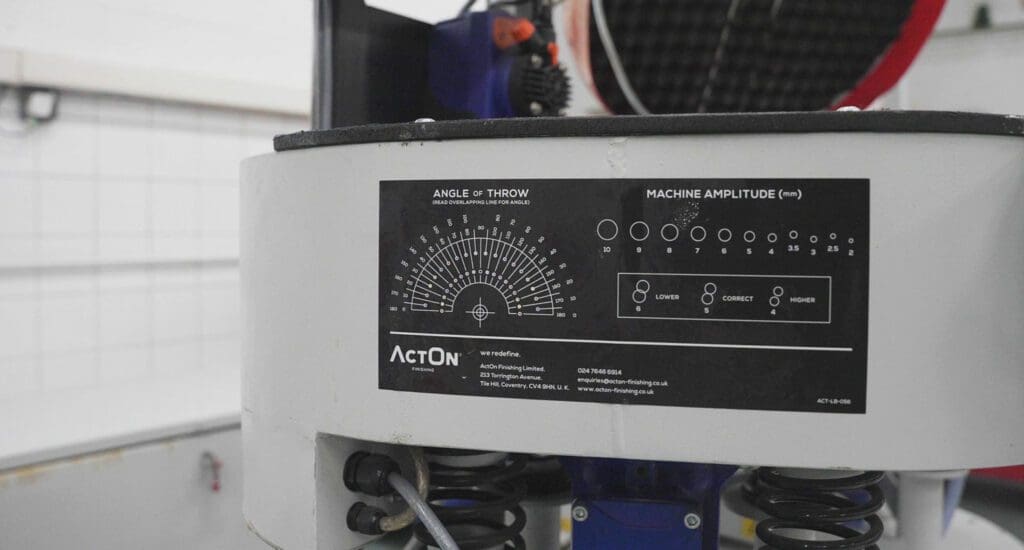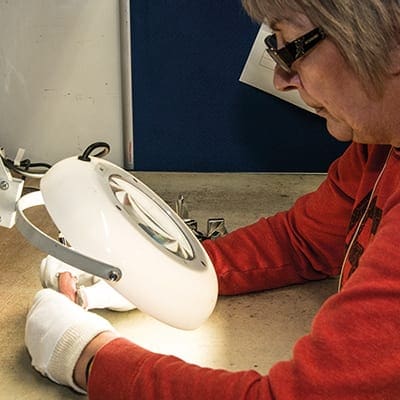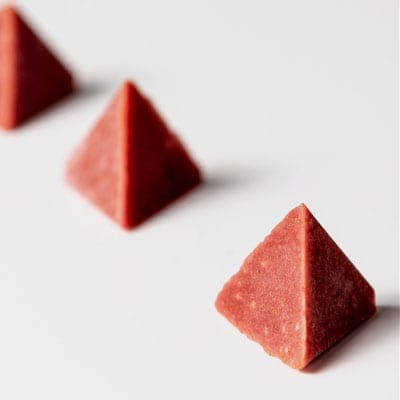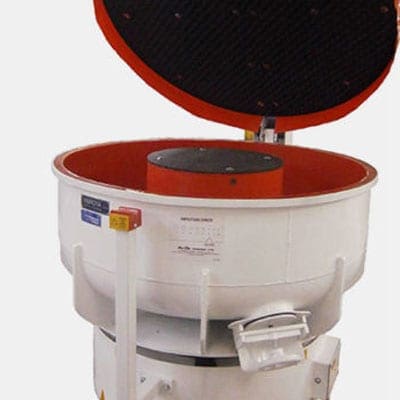
Looking to make the most of your vibratory finishing equipment? At ActOn Finishing, we’ve got you covered. Let’s discuss our key tips on setting parameters on your vibratory finishing machine and understanding how to check your machine is working correctly.
One of the key elements to any efficient finishing process is to ensure the machine itself is set up correctly. This encompasses a few different checks and processes which we’ll guide you through today in our video and blog below…
1. Make sure your vibratory finishing machine is running correctly
Your vibratory finishing machine must be moving in a spiral motion, where the media and parts run into the centre of the machine.
Occasionally when machines are wired in or moved, the phases can often be connected the wrong way round, this can mean that rather than rolling into the centre of the machine, the mass will fall away to the outside of the machine. This will have a direct impact on the time and effectiveness of the process.
An easy way to check if the vibratory finishing machine is running correctly, is to place a handful of media into the centre of the machine and if the media pulls into the centre then the machine is running correctly, if not, the phases need to be checked.
2. Check amplitude
Most vibratory finishing machines will run at around 4-5mm. A quick and easy way to check your machine is running at this amplitude, is to place a sticker on the outside of the machine. Once the machine starts to run, the sticker will vibrate and whichever circle overlaps perfectly is showing the correct amplitude on the machine.
3. Set up the water and compound dosing correctly
Although some customers use a closed loop process, the majority of vibratory finishing machines use an open loop process; where fresh water and compounds are continually doused into the machine and out to drain.
If too little or too much water is being doused into the machine and, likewise with a liquid compound, then processes can become ineffective and risk damaging parts and the machine.
The best way to ensure this process is set up correctly is by using a dosing unit. The dosing unit has a solenoid valve, flow metre and dosing pump. Once the solenoid valve is open, you can adjust the flow metre to ensure the right amount of water is being delivered to the vibratory finishing machine.
Although this will vary between processes and size of machine, on average, a machine will use around 1 litre per minute of water. The dosing pump can be adjusted to change both the amount and frequency of compound being dosed, again, this will vary between processes, but normally companies will dose at a 1-3% solution of compound to water.
An easy way to check this is to take a measuring jug and set a minute timer. At the end of the minute, you can see how much compound has been collected and work the percentage out from there.
4. Check the media level inside the vibratory finishing machine
Although this is more of a visual check, at ActOn Finishing, we can manufacture machines with a media gauge built into the lining of the machine – this will ensure the operators always have a visual to check against.
Your vibratory finishing machine should be around ⅔ full with media. Too much media will place extra strain on the springs and motor, and too little can damage parts and result in an inefficient process, where parts are not fully finished or the process takes longer than needed.
Summary of things to ensure with your vibratory finishing machine:
- Make sure the phases have been properly checked and connected – machine should move in a spiral motion
- Check machine amplitude – should be around 4-5mm
- Check water and compound dosing – use a dosing unit
- Get a media gauge built into your machines lining to check media levels inside
At ActOn Finishing, we offer a range of vibratory finishing machines, methods and finishing processes to suit your specific needs. For any advice on your process or machinery get in touch with us today.
FAQs
What is a vibratory finishing machine?
As a common finishing method in the manufacturing industry, vibratory finishing is an efficient process used to optimise all types of small products and parts. Vibratory finishing machines help you clean and deburr products at a faster pace.
What is vibratory deburring?
Vibratory deburring removes the rough edges from parts and enables them to fit together more efficiently. This leads to fewer part rejections as well as improved safety. In addition, deburring is an important step in preparing parts for painting.
How does vibratory polishing work?
In this stage a combination of media, parts and compounds are placed in a vibrating machine. The vibrations cause the contents to move in a circular motion and the media to grind against the part to get the desired finish.
What is a tumbling barrel?
Barrel finishing, also known as barrel tumbling or vibratory finishing, is a surface improving operation in which a mixture of parts, media and compounds are placed in a six- or eight-sided barrel and rotated at a predetermined speed for the purpose of rounding corners, deburring, grinding, descaling, deflashing, improving surface finish and much more.
What are the different types of finishing?
There are several types of metal finishing such as metal plating, chemical finishing or coating, grinding, buffing, electroplating, and sandblasting. Each process has basic steps with all processes beginning with surface preparation. Metal finishing processes can include anything from technical processes to buffers.












